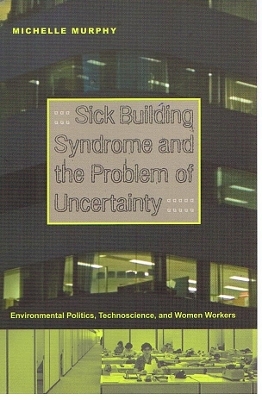
Sick Building Syndrome and the Problem of Uncertainty
Environmental Politics, Technoscience, and Women Workers
Seiten
2006
Duke University Press (Verlag)
978-0-8223-3671-6 (ISBN)
Duke University Press (Verlag)
978-0-8223-3671-6 (ISBN)
A detailed history of how sick building syndrome came into being: how indoor exposures to chemicals wafting from synthetic carpet, solvents, and so on became something that office workers felt and protested against
Before 1980, sick building syndrome did not exist. By the 1990s, it was among the most commonly investigated occupational health problems in the United States. Afflicted by headaches, rashes, and immune system disorders, office workers—mostly women—protested that their workplaces were filled with toxic hazards; yet federal investigators could detect no chemical cause. This richly detailed history tells the story of how sick building syndrome came into being: how indoor exposures to chemicals wafting from synthetic carpet, ink, adhesive, solvents, and so on became something that relatively privileged Americans worried over, felt, and ultimately sought to do something about. As M. Murphy shows, sick building syndrome provides a window into how environmental politics moved indoors. Sick building syndrome embodied a politics of uncertainty that continues to characterize contemporary American environmental debates. Murphy explores the production of uncertainty by juxtaposing multiple histories, each of which explains how an expert or lay tradition made chemical exposures perceptible or imperceptible, existent or nonexistent. They show how uncertainty emerged from a complex confluence of feminist activism, office worker protests, ventilation engineering, toxicology, popular epidemiology, corporate science, and ecology. In an illuminating case study, she reflects on EPA scientists’ efforts to have their headquarters recognized as a sick building. Murphy brings all of these histories together in what is not only a thorough account of an environmental health problem but also a much deeper exploration of the relationship between history, materiality, and uncertainty.
Before 1980, sick building syndrome did not exist. By the 1990s, it was among the most commonly investigated occupational health problems in the United States. Afflicted by headaches, rashes, and immune system disorders, office workers—mostly women—protested that their workplaces were filled with toxic hazards; yet federal investigators could detect no chemical cause. This richly detailed history tells the story of how sick building syndrome came into being: how indoor exposures to chemicals wafting from synthetic carpet, ink, adhesive, solvents, and so on became something that relatively privileged Americans worried over, felt, and ultimately sought to do something about. As M. Murphy shows, sick building syndrome provides a window into how environmental politics moved indoors. Sick building syndrome embodied a politics of uncertainty that continues to characterize contemporary American environmental debates. Murphy explores the production of uncertainty by juxtaposing multiple histories, each of which explains how an expert or lay tradition made chemical exposures perceptible or imperceptible, existent or nonexistent. They show how uncertainty emerged from a complex confluence of feminist activism, office worker protests, ventilation engineering, toxicology, popular epidemiology, corporate science, and ecology. In an illuminating case study, she reflects on EPA scientists’ efforts to have their headquarters recognized as a sick building. Murphy brings all of these histories together in what is not only a thorough account of an environmental health problem but also a much deeper exploration of the relationship between history, materiality, and uncertainty.
M. Murphy is Assistant Professor in the History Department and the Women and Gender Studies Institute at the University of Toronto.
Acknowledgments ix
Introduction 1
1. Man in a Box: Building-Machines and the Science of Comfort 19
2. Building Ladies into the Office Machine 35
3. Feminism, Surveys, and Toxic Details 57
4. Indoor Pollution at the Encounter of Toxicology and Popular Epidemiology 81
5. Uncertainty, Race, and Activism at the EPA 111
6. Building Ecologies, Tobacco, and the Politics of Multiplicity 131
7. How to Build Yourself a Body in a Safe Space 151
Epilogue 179
Bibliography 181
Notes 213
Index 241
| Zusatzinfo | 21 Illustrations |
|---|---|
| Verlagsort | North Carolina |
| Sprache | englisch |
| Maße | 156 x 229 mm |
| Gewicht | 408 g |
| Themenwelt | Naturwissenschaften ► Biologie ► Ökologie / Naturschutz |
| Sozialwissenschaften ► Politik / Verwaltung ► Politische Theorie | |
| Sozialwissenschaften ► Soziologie ► Allgemeines / Lexika | |
| ISBN-10 | 0-8223-3671-5 / 0822336715 |
| ISBN-13 | 978-0-8223-3671-6 / 9780822336716 |
| Zustand | Neuware |
| Haben Sie eine Frage zum Produkt? |
Mehr entdecken
aus dem Bereich
aus dem Bereich


